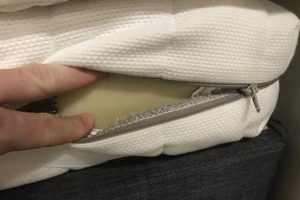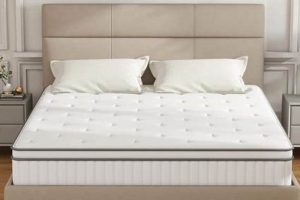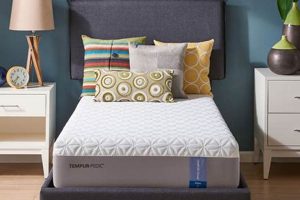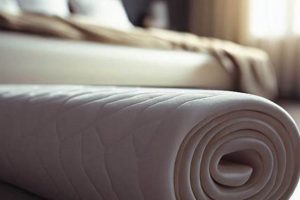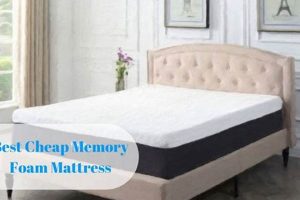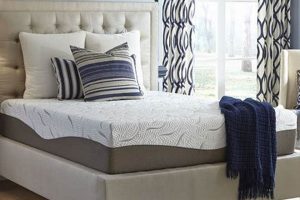These specialized canine beds are designed with visco-elastic foam, a material known for conforming to the body’s shape and evenly distributing weight. This characteristic is particularly beneficial for canines, as it provides support and pressure relief to joints and muscles. For example, an aging dog with arthritis may experience less pain and discomfort when resting on this type of bed compared to a standard dog bed.
The significance of utilizing visco-elastic foam lies in its ability to alleviate pressure points, promote healthy spinal alignment, and enhance circulation. Historically, orthopedic beds for humans incorporated similar foam technology, leading to its subsequent adoption for canine use. The advantages include improved sleep quality, reduced stiffness, and potential mitigation of certain age-related ailments. The enhanced comfort encourages restful sleep, which is essential for the overall health and well-being of the animal.
The following sections will explore the various aspects of these specialized pet beds, including factors to consider when selecting the appropriate option, the materials and construction techniques used, and the potential health advantages for different types of canines. An examination of cleaning and maintenance procedures will also be provided, ensuring the longevity and hygienic condition of this bedding investment.
Guidance on Optimal Selection and Utilization
The following recommendations aim to facilitate informed decisions regarding the selection and proper implementation of visco-elastic canine bedding. These suggestions emphasize factors that influence the comfort, support, and longevity of the product.
Tip 1: Assess Canine Size and Weight: Prior to purchase, accurately measure the canine’s dimensions and consider its weight. The bed should be adequately sized to allow the animal to fully stretch out and turn comfortably without hanging off the edges. Insufficient dimensions negate the intended support benefits.
Tip 2: Evaluate Foam Density: Visco-elastic foam density is a crucial factor affecting support and durability. Higher density foams generally provide greater support and resist compression over time. Research the density specifications to ensure the selected product aligns with the canine’s weight and long-term use requirements.
Tip 3: Consider Orthopedic Needs: If the canine has pre-existing orthopedic conditions such as arthritis or hip dysplasia, prioritize beds designed with orthopedic features. These models often incorporate denser foam layers and specialized contours to provide targeted support and pressure relief to affected joints.
Tip 4: Investigate Cover Material: The cover material should be durable, water-resistant, and easily removable for cleaning. Look for options made from heavy-duty fabrics that can withstand scratching and biting, while also providing a comfortable sleeping surface. Waterproof liners can further protect the foam core from accidents.
Tip 5: Examine Construction Quality: Scrutinize the overall construction quality, including seams, stitching, and zipper closures. Reinforced seams and sturdy zippers contribute to the bed’s longevity and prevent premature wear and tear. Avoid products with loose threads or flimsy components.
Tip 6: Consider Bed Height: The height of the bed should be appropriate for the canine’s age and mobility. Older or arthritic dogs may benefit from lower-profile beds that are easier to access. Puppies or smaller breeds may require beds with higher sides for added security and containment.
Tip 7: Establish a Cleaning Routine: Regular cleaning is essential for maintaining hygiene and extending the lifespan. Follow the manufacturer’s instructions for washing or spot-cleaning the cover. Periodically air out the foam core to prevent moisture buildup and odor retention.
Adherence to these guidelines can significantly enhance the canine’s resting experience, potentially mitigating discomfort and promoting overall well-being. Prioritizing proper selection and maintenance ensures the continued effectiveness of this specialized bedding.
The subsequent discussion will address common misconceptions and concerns related to these specialized canine beds, providing further clarification and addressing potential challenges.
1. Support
The fundamental link between support and visco-elastic foam canine beds lies in the material’s inherent ability to conform to the animal’s body, evenly distributing its weight. The cause is the visco-elastic property of the foam, which reacts to both pressure and temperature. The effect is a reduction in pressure points, which can lead to improved circulation and decreased joint stress. Support is a critical component; without adequate support, the bed fails to provide the intended orthopedic benefits. For instance, a canine suffering from hip dysplasia requires consistent support to the hip joints. A visco-elastic foam bed, when properly designed and of sufficient density, can deliver this support, alleviating pain and improving the animal’s ability to rest comfortably. Understanding this connection is practically significant because it informs the selection process, ensuring that the chosen bed is appropriate for the individual canine’s needs.
Further analysis reveals that the level of support provided is directly related to the foam’s density and thickness. Higher-density foams offer greater resistance to compression, maintaining their supportive properties over time. Thicker foam layers also contribute to improved support by providing a larger surface area for weight distribution. In practical applications, this means that heavier canines or those with more severe orthopedic conditions require beds with higher density and greater thickness to achieve the desired level of support. A smaller, lighter breed may benefit from a less dense and thinner foam, as excessive firmness can be counterproductive and uncomfortable. The choice of supportive structure beneath the foam layer, such as a high-density base foam, also contributes to the overall stability and prevents “bottoming out” of the bed, which negates the pressure-relieving effect.
In summary, the connection between support and visco-elastic foam canine beds is based on the foam’s physical properties, which enable it to contour to the animal’s body and distribute weight evenly. The level of support provided is dependent on factors such as foam density, thickness, and underlying support structure. Challenges arise in accurately assessing the canine’s specific needs and selecting a bed that meets those needs effectively. Addressing these challenges requires careful consideration of the animal’s weight, size, orthopedic condition, and sleep preferences, ultimately linking back to the broader theme of enhancing canine well-being through informed bedding choices.
2. Comfort
Comfort, in the context of visco-elastic foam c
anine mattresses, transcends mere softness; it is an encompassing factor that influences rest quality, physical health, and overall well-being. Its relationship with these beds is paramount, as even the most supportive mattress fails if it is not conducive to canine relaxation and rest.
- Pressure Relief and Body Contouring
Visco-elastic foam’s conforming properties reduce pressure points, promoting circulation and minimizing discomfort. This is particularly crucial for senior canines or those with arthritis, where prolonged pressure on joints can exacerbate pain. For instance, a canine with elbow dysplasia may experience marked relief from lying on a conforming surface compared to a traditional, less-yielding bed. This relief translates directly into improved sleep patterns and a more restful recovery.
- Temperature Regulation
Some visco-elastic foams incorporate gel infusions or open-cell structures to regulate temperature. Overheating can lead to restlessness and discomfort, particularly in breeds prone to heat sensitivity. A temperature-regulating mattress aids in maintaining a consistent and comfortable sleep environment, preventing the animal from becoming overheated or chilled. This aspect of comfort extends beyond the surface feel, impacting physiological comfort as well.
- Surface Texture and Material Properties
The cover material of the mattress significantly influences the tactile experience. Soft, breathable fabrics, such as microfibers or plush fleece, can enhance comfort by providing a pleasant sleeping surface. Conversely, rough or abrasive materials can irritate the skin and detract from the overall comfort. The choice of material should align with the canine’s coat type and any potential sensitivities to specific fabrics.
- Psychological Security
Comfort extends beyond the physical realm and encompasses psychological security. A familiar, comfortable bed can provide a sense of safety and reassurance, particularly for anxious or stressed canines. The bed becomes a haven, a place where the animal feels secure and protected. This psychological aspect of comfort contributes to a more relaxed and restful state, promoting overall well-being. Features such as raised edges or bolstered sides can further enhance this sense of security.
In summary, comfort in relation to visco-elastic foam canine mattresses is a multifaceted concept encompassing pressure relief, temperature regulation, surface texture, and psychological security. These elements interrelate to create an optimal resting environment. The effectiveness of the mattress is ultimately judged by its ability to promote relaxation, reduce discomfort, and enhance the canine’s overall quality of life. Comparative analyses of different materials and designs underscore the impact of these elements on the animal’s resting experience.
3. Durability
The enduring nature of a visco-elastic foam canine mattress correlates directly with its value as a long-term investment in pet care. The inherent cause of degradation lies in the continuous compression and exposure to environmental factors typical of daily usage. The effect of compromised durability manifests as reduced support, diminished comfort, and ultimately, the need for premature replacement. Durability serves as a critical component, ensuring the sustained effectiveness of the product in providing orthopedic support and pressure relief, particularly for aging or arthritic animals. For instance, a poorly constructed mattress may exhibit significant compression after only a few months of use, negating its intended benefits and forcing an unanticipated expenditure for a replacement. Understanding this connection underscores the practical significance of selecting a mattress built to withstand prolonged use and maintain its structural integrity.
Further analysis reveals that material selection and construction techniques play pivotal roles in determining longevity. Higher-density visco-elastic foam, coupled with robust cover fabrics and reinforced stitching, contributes significantly to resistance against wear and tear. Waterproof liners, integrated beneath the cover, protect the foam core from urine and other liquids, mitigating potential damage and odor retention. The choice of materials must therefore align with the intended use environment and the canine’s behavioral tendencies. For example, a mattress designed for a high-energy dog prone to chewing requires a more durable and tear-resistant cover than one intended for a calmer, less destructive animal. Practical applications of this understanding include thorough examination of product specifications, user reviews, and warranty terms before purchase.
In summary, the connection between durability and visco-elastic foam canine mattresses is established through material quality, construction methods, and resistance to environmental stressors. The primary challenge resides in accurately assessing the long-term performance characteristics of a given product based on available information. Addressing this challenge necessitates a comprehensive approach, considering product specifications, user feedback, and brand reputation. Ultimately, prioritizing durability in the selection process translates to a more cost-effective and sustainable solution, fostering both canine well-being and responsible pet ownership.
4. Hygiene
The hygienic condition of a visco-elastic foam canine mattress directly influences the health and well-being of the animal utilizing it. The primary cause for concern stems from the porous nature of foam, which can trap organic matter such as shed fur, skin cells, saliva, and urine. The effect is the potential proliferation of bacteria, fungi, and allergens within the mattress, creating an unsanitary environment. Hygiene is a critical component, as prolonged exposure to these contaminants can lead to skin irritations, allergic reactions, and respiratory problems in susceptible canines. For instance, a dog with atopic dermatitis may experience exacerbated symptoms when resting on a mattress harboring dust mites and fungal spores. Understanding this connection is practically significant because it dictates the frequency and rigor of cleaning protocols necessary to maintain a healthy resting environment.
Further analysis reveals that the mattress cover material and construction significantly impact hygienic maintenance. Water-resistant or waterproof covers prevent liquids from penetrating the foam core, reducing the risk of bacterial growth and odor retention. Removable covers that are machine washable facilitate thorough cleaning, eliminating accumulated debris and allergens. Antimicrobial treatments applied to the foam or cover can further inhibit microbial proliferation. Consider the practical application where a multi-dog household increases the likelihood of accidents and contamination. In such cases, selecting mattresses with waterproof covers and antimicrobial properties becomes paramount to maintain sanitary conditions and prevent cross-contamination between animals.
In summary, the connection between hygiene and visco-elastic foam canine mattresses is underscored by the potential for microbial growth and allergen accumulation within the foam core. The challenge resides in balancing the inherent porous nature of the foam with effective preventative measures, such as utilizing water-resistant covers, implementing regular cleaning schedules, and selecting products with a
ntimicrobial properties. Addressing this challenge contributes to a cleaner, healthier resting environment for canines, fostering overall well-being and minimizing the risk of hygiene-related health issues.
5. Orthopedic
The term “orthopedic,” when applied to canine bedding, specifically denotes features designed to alleviate musculoskeletal stress and promote healthy joint alignment. The relationship between “orthopedic” design and visco-elastic foam canine mattresses is that the foam’s conforming properties can be leveraged to achieve targeted support and pressure relief, addressing specific skeletal and muscular conditions common in canines.
- Pressure Redistribution
Orthopedic visco-elastic foam mattresses are engineered to redistribute weight evenly across the canine’s body, minimizing pressure concentrations on joints such as hips, elbows, and shoulders. This is particularly beneficial for dogs suffering from arthritis, hip dysplasia, or other joint ailments. For example, a study of canines with osteoarthritis showed reduced pain indicators when resting on pressure-redistributing visco-elastic foam compared to traditional fiber-filled beds. This reduction in pressure promotes improved circulation and decreases discomfort.
- Spinal Alignment Support
The conforming nature of the foam assists in maintaining proper spinal alignment during rest, which is essential for alleviating back pain and preventing further musculoskeletal issues. A properly designed orthopedic mattress will contour to the canine’s natural spinal curvature, providing support to the neck, back, and lumbar region. This is analogous to the principles used in human orthopedic mattresses, where spinal support is a primary design consideration. Improper alignment can exacerbate existing conditions and lead to chronic pain.
- Density and Firmness Considerations
The effectiveness of an orthopedic visco-elastic foam mattress is directly related to the density and firmness of the foam. Higher density foams provide greater support and resistance to compression, preventing the canine from “bottoming out” and negating the intended benefits. The firmness level should be appropriate for the canine’s weight and size; excessively soft foams may not provide adequate support, while overly firm foams can be uncomfortable. Manufacturers often provide weight recommendations for specific models to guide consumer selection.
- Edge and Bolster Support
Orthopedic designs frequently incorporate reinforced edges or bolstered sides to provide additional support and security for the canine. These features can aid in stability for dogs with mobility issues, preventing them from rolling off the bed and reducing the risk of injury. Bolsters also offer a comfortable headrest, promoting proper neck alignment. The presence of these features contributes to the overall therapeutic value of the mattress.
The facets detailed above illustrate that orthopedic visco-elastic foam canine mattresses represent a specialized category of pet bedding designed to address specific musculoskeletal needs. The effectiveness of these mattresses hinges on careful consideration of factors such as foam density, firmness, design features, and the individual canine’s condition. A properly selected orthopedic mattress can provide significant relief from pain and discomfort, improving the animal’s quality of life.
6. Size
The dimensions of a visco-elastic foam canine mattress correlate directly with its suitability and effectiveness. An inappropriately sized bed negates the intended orthopedic and comfort benefits. The cause stems from the fundamental requirement that the animal must be able to fully extend its body while resting, thereby ensuring adequate weight distribution across the entire surface of the foam. The effect of undersized bedding manifests as pressure points, restricted movement, and compromised sleep quality. Conversely, an excessively large bed may not provide the desired sense of security, particularly for smaller breeds, and can occupy unnecessary space. Size is therefore a critical component, impacting both physical comfort and psychological well-being. For instance, a Great Dane requires significantly more surface area than a Chihuahua to achieve complete support and unrestricted movement. Understanding this relationship underscores the practical significance of accurate measurement and informed selection.
Further analysis reveals that proper sizing extends beyond simple length and width considerations. The thickness of the foam layer must also be proportionate to the animal’s weight. A thicker foam core is necessary for heavier breeds to prevent bottoming out and ensure adequate support. The height of the bed can also be a factor, particularly for older or arthritic dogs who may have difficulty stepping onto elevated surfaces. Practical applications include measuring the canine in its typical sleeping position (fully stretched out) and adding a few inches to each dimension to allow for movement. Consulting size charts provided by manufacturers can also assist in selecting the appropriate model. Failure to consider these factors can lead to discomfort, reduced mobility, and ultimately, a diminished quality of life for the animal.
In summary, the connection between size and visco-elastic foam canine mattresses is established through the animal’s physical requirements for unrestricted movement, adequate support, and psychological comfort. The challenge resides in accurately assessing these needs and translating them into appropriate bed dimensions. Addressing this challenge necessitates careful measurement, consideration of breed-specific characteristics, and consultation with product specifications. Ultimately, prioritizing correct sizing ensures that the mattress effectively fulfills its intended purpose, promoting canine well-being and contributing to a positive resting experience.
Frequently Asked Questions About Memory Foam Mattress Dog Beds
This section addresses common inquiries regarding visco-elastic foam canine mattresses, providing factual information to aid in informed decision-making.
Question 1: Are memory foam canine beds suitable for all breeds?
Visco-elastic foam beds can benefit most breeds; however, consider individual needs. Larger breeds require higher-density foam for adequate support. Smaller breeds may prefer thinner, less dense options. Monitor individual canine preferences.
Question 2: How does one clean a memory foam canine bed effectively?
Cleaning procedures vary by model. Generally, remove and machine wash the cover. Spot clean the foam core with mild detergent and water. Ensure thorough drying to prevent mold growth.
Question 3: Do these beds retain heat, potentially causing discomfort?
Some visco-elastic foam retains heat. Opt for models with gel infusions or open-cell structures to promote airflow and temperature regulation.
Question 4: What is the expected lifespan of a visco-elastic foam canine bed?
Lifespan depends on usage and material quality. Higher-density foams and durable covers extend longevity. Expect a lifespan of several years with proper care.
Question 5: Are visco-elastic foam beds effective for canines with arthritis?
These beds can
alleviate arthritic discomfort by distributing weight evenly and reducing pressure on joints. Consult a veterinarian for personalized recommendations.
Question 6: How does one choose the correct size of memory foam mattress dog bed?
Measure the canine while it is lying down, then add several inches to both length and width. Ensure the animal can fully extend without hanging off the edges.
Proper selection and maintenance are paramount for maximizing the benefits of visco-elastic foam canine mattresses.
The subsequent section will provide concluding remarks, summarizing key considerations and reinforcing the importance of informed decision-making.
Conclusion
The preceding exploration of the specialized canine bedding underscores the multifaceted considerations involved in selecting appropriate rest surfaces for domesticated animals. The analysis has addressed key factors, including support mechanisms, comfort provisions, durability aspects, hygiene protocols, orthopedic designs, and size considerations, highlighting their interconnectedness in optimizing canine well-being. This analysis emphasizes the importance of discerning product attributes and aligning them with the unique needs of the individual animal.
The decision to invest in a memory foam mattress dog bed should not be based solely on superficial characteristics or marketing claims. Instead, it requires a careful evaluation of the product’s construction, materials, and intended application. Prioritizing informed decision-making ensures that the selected bedding contributes effectively to the animal’s comfort, health, and overall quality of life, thereby reinforcing the responsible stewardship of companion animals and their needs.


